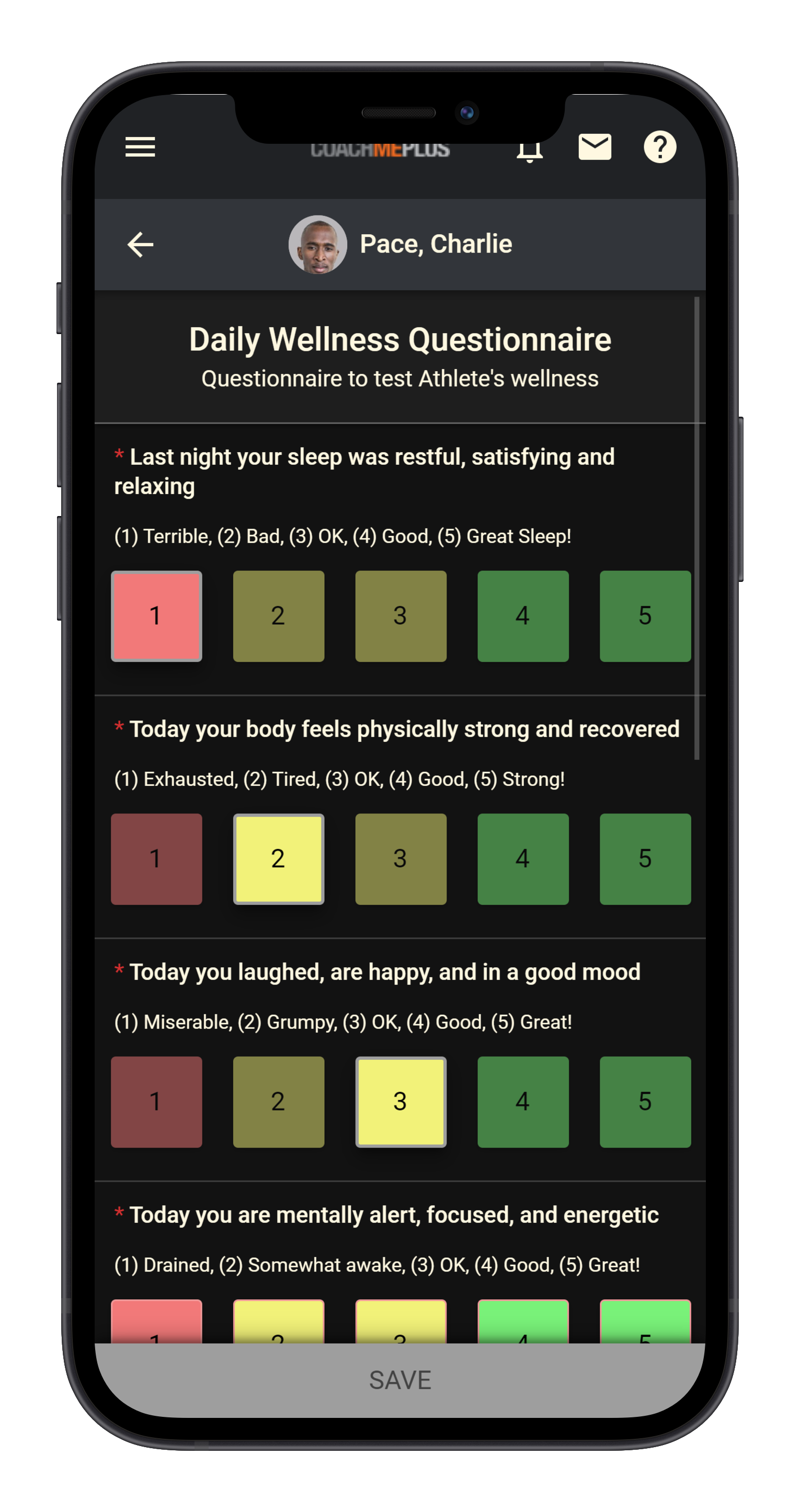
“Not so much a ‘no pain, no gain’ culture anymore in coaching and training. It’s a lot of load monitoring and careful planning, but it also includes making adjustments on the fly.” — Michael Gallivan, ACSM.
In the 2020 Olympics, Naomi Osaka, a multiple grand slam winner, surprised the world when she said she didn’t want to participate in the most anticipated event in sport. From the outside looking in, everything looked okay. She appeared to be prepared and ready for athletic competition, and many just couldn’t understand why she would choose not to perform.
Even before the dust from the Naomi Osaka controversy had settled, four-time gold medalist Simeon Biles would shock the airwaves again. This time, by pulling out of the competition at a time when many said, “her team needed her most.”
The two instances would bring to the surface two discussions the athletic performance and coaching community has been avoiding for years—the balance between subjective wellness and objective measures of performance.

What Is Subjective Wellness?
Recent advances in human performance show that objective measures alone aren’t sufficient to evaluate and diagnose an athlete’s performance. This necessitates the need for the athlete’s own perspective of readiness, also known as subjective wellness.
Subjective wellness is an athlete’s perception of how they feel. Perception is reality; they might not have a physical reason to underperform, but if they are mentally unfocused and encumbered by stress, mood or expect to perform badly, their performance will likely mirror those thoughts. All types of physical training induce strain on an athlete’s body. That said, there are healthy levels of strain that improve the athlete, as well as chronic unhealthy ones that are unproductive.
Coaches track an athlete’s objective and subjective performance as indicators of the strain on the athlete and whether they are over, optimum, or under training the athlete. A coach can then use this data to adjust load and workouts.
Determining Objective Wellbeing (Load and Threshold) Before Subjective Wellness Is Considered
Subjective wellness can be used to diagnose and fix problems in an athlete’s performance. However, this process is much more efficient if objective wellness (load and recovery) precedes subjective well-being.
In layman terms, a coach or an athlete can use objective wellness to diagnose performance (find out the “if”) and subjective wellness to get to the root cause of the problem (the “why”). There is no one-size-fits-all approach for determining objective well-being. One of the most efficient ways is by determining the load as shown below:
1. Determine load (for example, you can test vertical jump twice a week.)
To develop an efficient objective measurement process, the schedule should have consistency. For example, the athlete should be tested at the same time each day of each week. This consistency helps to control for other factors such as hormonal levels and body weight that fluctuate throughout the day.
Once you find a preferable day of the week for internal load monitoring, you can then test for vertical jump and come up with a trajectory each week.
If the numbers over time are staying the same – Little or no change in numbers means the athlete’s performance is okay. Moreover, it shows consistency and that the athlete is comfortable with the level of strain during workouts and practice.
If their numbers are improving – An improvement in numbers is great. It shows that the workouts are effective and that the athlete’s body is responding positively to the workouts. Coaches should take improvements as seriously as they handle deteriorations. The data on why an athlete is making improvements goes a long way in finding ways to further cement those habits.
If their numbers are getting worse – A worsening performance is a cause of concern for all parties. That said, load determination alone doesn’t give a clearer picture. For more insight, the coach should analyze the data from wearable devices.
Analysis of Strain Data from Wearable Devices
If the dashboard on a wearable fitness device reads high strain and low recovery scores, the coach should take a very calculated approach to the matter.
Trainers should consider steering clear of talking points that are complete, conclusive sentences like:
- “You’re not pushing yourself.”
- “Try harder.”
- “You can do better.”
A better alternative would be to ask open-ended questions from a subjective wellness perspective about what’s going on outside the workouts and practice. Topics one can touch on include sleeping patterns, eating patterns, and stress levels.

Where Subjective Wellness Comes In
Subjective wellness adds insight whenever the numbers don’t follow as expected. This doesn’t necessarily mean that the athlete is underperforming; it goes both ways. Context of the data is sometimes more important than the outcomes of the data alone. Understanding where an athlete is within their performance helps complete the picture.
Subjective wellness could also come in handy when there are significant improvements in performance. If this is the case, the coach can proceed to find what the athlete is doing differently (outside practice) and encourage it. A trainer should take into account how the athlete feels during load management, and adjust workouts based on stress, sleep and nutrition.
Stress
An optimum amount of stress can help an athlete prepare, train, and perform at optimum levels. However, an unhealthy amount of stress can impact an athlete’s performance. That said, when determining load and workouts, a coach must have the stress of the athlete in mind.
Sleep
The amount, quality, and pattern of sleep have a significant effect on an athlete’s performance. A Stanford study shows that collegiate basketballers who were able to increase their sleep to 10 hours a night improved their shooting by 9%. That said, data on an athlete’s sleep comes in handy when determining both loads and training intensity. Even more crucial is when a coach is diagnosing fluctuations in performance.
Nutrition
Nutrition is another outside practice variable that has a huge vote on the performance of an athlete. That said, nutrition is a broad area. It covers everything from hydration, supplementation, portions, medications, and diet, all parameters that trainers should put under the spotlight.
Of all external factors, the nutrition of an athlete is the most crucial for both long-term and short-term performance. Any issues that arise from improper nutrition should be identified and mitigated as quickly as possible.
2. Using wearables to monitor the metabolic rate and sprint times or other loads
Another effective approach to measuring objective well-being is leveraging data from wearables to monitor metabolic rates and sprint times continuously. Both techniques, using wearables and load determination, are crucial in monitoring objective wellness. In fact, they are equally effective, and it’s recommended that trainers use them simultaneously.
Direct data has fewer external variables and hence allows coaches to err on the side of caution. You need both because someone may feel great despite being at a threshold or tapped out before reaching the expected limit. Both mismatched expectations must be addressed for healthy and sustained growth.
Benefits Beyond Physical Monitoring
The benefits of subjective well-being spill beyond physical monitoring and the development of better practices. Athlete subjective wellness monitoring helps make the life of an athlete better both in practice and outside the court.
Some of its benefits include:
1. Improved Motivation and Well-being
Show me a stressed athlete, and I’ll show you an underperformer. If an athlete is stressed and just going through the motions because the coach is pushing while ignoring the issues, it can lead to burnout.
However, if the coach takes the athlete’s stress and subjective well-being into account and assigns a recovery program, trust is built. The athlete feels genuine concern from the coach and is inclined to work harder for the coach in the future.
2. Self-Awareness
Humans value autonomy and the feeling of being in charge. Self-reporting raises awareness on the athlete’s part about how decisions outside of the gym can affect performance.
With self-reporting through subjective awareness, athletes can see for themselves the consequences of each action they take. An athlete can see for themselves that once they start to eat certain foods, they perform better or worse later. Similarly, if they’ve been sleeping poorly, they will notice that they can’t meet their performance expectations, further showing them that actions have consequences.
This gives them the incentive to address the actual sleep issues and concentrate on plausible causes such as caffeine intake.
3. Better Mental Health
The mental health question in elite athletes started way before Naomi Osaka and Simone Biles came to the spotlight.

With thousands of fans, supporters, friends, and family, it’s hard for many to believe that athletes sometimes may suffer from depression, loneliness, and have deep-seated issues of their own. To make it worse, objective forms of measurement fail to identify mental health challenges athletes face.
An approach that focuses on mental health, such as subjective well-being, can help identify early signs of deterioration that may slip through the fingers of objective forms of measurement. As a result, athletes get the necessary treatment and counseling early and before it’s too late.
How to Track Subjective Wellness
As you’ve seen above, self-awareness and putting the athlete in the driver’s seat of the subjective wellness process come with several benefits. One of the best ways to track subjective wellness while at the same time offering the athlete both autonomy and self-awareness is using a wellness questionnaire for athletes.
CoachMePlus was founded with the dream of leveraging modern technology to help coaches and athletes achieve their fitness goals. For more information about objective and subjective measurement of athletes’ performance, contact us today, and our teams will be more than willing to help.
Keep Reading:
How Temperature Impacts Load Monitoring in Athlete Performance
When it comes to athlete performance and recovery, most sports academies focus on metrics like heart rate, velocity, perceived exertion, and training volume. But one critical factor often gets overlooked: temperature. Whether training indoors or outdoors, ambient...
Why Your Sports Academy Needs an Athlete Management System
Modernize Athlete Development and Performance Tracking In the fast-evolving world of sports performance, spreadsheets are no longer enough. As sports academies grow in size, complexity, and ambition, the need for streamlined, centralized, and data-driven solutions has...
Wellness Questionnaires: The Most Underused Tool in Sports Performance
Most teams use GPS. Many track heart rate. Some monitor sleep. Few consistently use wellness questionnaires. In an era where wearable technology and biometric monitoring dominate high-performance sports, teams frequently overlook wellness questionnaires. However,...




Recent Comments